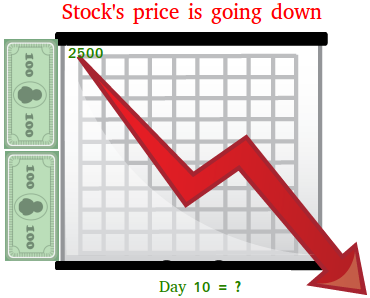Geometric sequence word problems
This lesson will show you how to solve a variety of geometric sequence word problems.
Example #1:
The stock's price of a company is not doing well lately. Suppose the stock's price is 92% of its previous price each day. What is the stock's price after 10 days if the stock was worth $2500 right before it started to go down?

Solution
To solve this problem, we need the geometric sequence formula shown below.
an = a1 × r(n - 1)
a1 = original value of the stock = 2500
a2 = value of the stock after 1 day
a11 = value of the stock after 10 days
r = 0.92
a11 = 2500 × (0.92)(11 - 1)
a11 = 2500 × (0.92)10
a11 = 2500 × 0.434
a11 = $1085
The stock's price is about 1085 dollars.
Example #2:
The third term of a geometric sequence is 45 and the fifth term of the geometric sequence is 405. If all the terms of the sequence are positive numbers, find the 15th term of the geometric sequence.
Solution
To solve this problem, we need the geometric sequence formula shown below.
an = a1 × r(n - 1)
Find the third term
a3 = a1 × r(3 - 1)
a3 = a1 × r2
Since the third term is 45, 45 = a1 × r2 (equation 1)
Find the fifth term
a5 = a1 × r(5 - 1)
a5 = a1 × r4
Since the fifth term is 405, 405 = a1 × r4 (equation 2)
Divide equation 2 by equation 1.
(a1 × r4) / (a1 × r2) = 405 / 45
Cancel a1 since it is both on top and at the bottom of the fraction.
r4 / r2 = 9
r2 = 9
r = ±√9
r = ±3
Use r = 3, and equation 1 to find a1
45 = a1 × (3)2
45 = a1 × 9
a1 = 45 / 9 = 5
Since all the terms of the sequence are positive numbers, we must use r = 3 if we want all the terms to be positive numbers.
an = a1 × r(n - 1)
Let us now find a15
a15 = 5 × (3)(15 - 1)
a15 = 5 × (3)14
a15 = 5 × 4782969
a15 = 23914845
Challenging geometric sequence word problems
Example #3:
Suppose that the magnification of a PDF file on a desktop computer is increased by 15% for each level of zoom. Suppose also that the original length of the word "January" is 1.2 cm. Find the length of the word "January" after 6 magnifications.
Solution
To solve this problem, we need the geometric sequence formula shown below.
an = a1 × r(n - 1)
a1 = original length of the word = 1.2 cm
a2 = length of the word after 1 magnification
a7 = length of the word after 6 magnifications
r = 1 + 0.15 = 1.15
n = 7
a7 = 1.2 × (1.15)(7 - 1)
a7 = 1.2 × (1.15)6
a7 = 1.2 × (1.15)6
a7 = 1.2 × 2.313
a7 = 2.7756
After 6 magnifications, the length of the word "January" is 2.7756 cm.
Notice that we added 1 to 0.15. Why did we do that? Let us not use the formula directly so you can see the reason behind it. Study the following carefully!
Day 1: a1 = 1.2
Day 2: a2 = 1.2 + 1.2(0.15) = 1.2(1 + 0.15)
Day 3: a3 = 1.2(1 + 0.15) + [1.2(1 + 0.15)]0.15 = 1.2(1 + 0.15)(1 + 0.15) = 1.2(1 + 0.15)2
Day 7: a7 = 1.2(1 + 0.15)6
Example #4
Suppose that you want a reduced copy of a photograph. The actual length of the photograph is 10 inches. If each reduction is 64% of the original, how many reductions, will shrink the photograph to 1.07 inches.
Solution
an = a1 × r(n - 1)
a1 = original length of the photograph = 10 inches
a2 = length of the photograph after 1 reduction
an = 1.07
r = 0.64
n = number of reductions = ?
1.07 = 10 × (0.64)(n - 1)
Divide both sides by 10
1.07 / 10 = [10 × (0.64)(n - 1)] / 10
0.107 = (0.64)(n - 1)
Notice that you have an exponential equation to solve. The biggest challenge then is knowing how to solve exponential equations!
Take the natural log of both sides of the equation.
ln(0.107) = ln[(0.64)(n - 1)]
Use the power property of logarithms.
ln(0.107) = (n - 1)ln(0.64)
Divide both sides of the equation by ln(0.64)
ln(0.107) / ln(0.64) = (n - 1)ln(0.64) / ln(0.64)
n - 1 = ln(0.107) / ln(0.64)
Use a calculator to find ln(0.107) and ln(0.64)
n - 1 = -2.23492644452 \ -0.44628710262
n - 1 = 5.0078
n = 1 + 5.0078
n = 6.0078
Therefore, you will need 6 reductions.